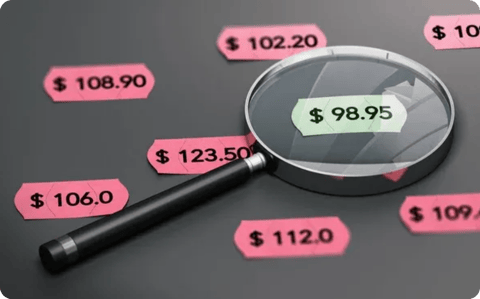BLOG
How Sales Teams Can Address B2B Customer Concerns About Lower B2C Prices

AUTHOR
Anya Policht
DATE OF PUBLICATION
March 2023
TIME TO READ
4 minutes
We know navigating pricing conversations can be difficult as B2B buyers look for ways to lower their costs to remain competitive and maximize profits. So, it’s no wonder they become frustrated when they see lower B2C prices for the same goods — especially after years of loyalty.
With inflation running high and gloomy economic forecasts, buyers are more scrutinizing when looking for ways to save money. That’s why having a strategy to help your sales team handle tough pricing conversations is more important than ever. Read on to discover four tips to effectively handle customer concerns about differences between B2B and B2C prices.
How to turn frustrated B2B buyers into life-long customers in four easy steps
Step 1: Adopt a more strategic approach to pricing
First things first, don’t panic! B2B customers may question lower retail prices, but it’s important not to jeopardize your profitability by doing one of the following:
- Dropping your prices: It can be tempting for sales reps to use discretionary discounts or one-time offers to appease frustrated customers. However, doing so means you start chasing another market, since the B2B business model is fundamentally different from the B2C one.
- Removing the product listing: Customers want the goods you’re selling, so removing the listing from your website to avoid any short-term pricing disparity means losing sales.
While these responses may be the first reflex to appease customers, you should instead take a more strategic approach to dealing with price concerns by following the below recommendations.
Step 2: Explain the nature of B2C price fluctuations
Educate customers as to why pricing discrepancies occur and why they are deceptive. In general, lower B2C prices occur for one of three reasons:
- Promotional campaigns that artificially lower prices for a short period of time
- Pure players offer lower B2C prices as they specialize in a small range of goods, allowing them to manufacture at greater economies of scale
- Aggressive B2C pricing on a limited number of products can cause the equivalent B2B product prices to appear higher
It’s vital for customers to understand how these are limited in time and in product selection, or, in the case of pure players, may not be an option for B2B customers.
Step 3: Highlight the unique benefits of B2B relationships
Your sales team should demonstrate how B2B and B2C customer relationships are fundamentally different. In doing business with you, your customers gain a long-term strategic partner that can enable their growth ambitions and provide a variety of additional benefits, support, and value-added services.
Some of these unique benefits for B2B customers include:
- Guaranteed prices and stock levels
- Predefined credit agreements and Incoterms
- Price change alerts ahead of time
- Early-bird discounts and access to new product innovations
- SLA and prioritized support
- Volume or performance-related rebates and long-term loyalty schemes
- Compliance measures, like purchasing policies and global brand image
- Access to free products and giveaways
These advantages are a crucial part of a thriving B2B relationship, so sales reps should emphasize their added value that outweighs price disparities caused by short-term B2C price fluctuations.
Step 4: Prioritize open and regular customer communication
Finally, upon seeing lower retail prices, B2B customers will want to ask questions, so it’s essential to provide as much support as possible through regular and open contact. This not only allows your sales reps to address issues early on, but also helps buyers build trust in your business and become life-long customers. So, embrace a customer-centric communication strategy by adopting the following tactics:
- Check-in regularly: Establish a consistent line of communication, ideally through the same account manager. This way customers feel valued and comfortable to pose questions to a team member who is already familiar with their wider business needs.
- Use multiple channels: Accommodate customer communication preferences, including phone calls, emails, instant messaging platforms, or video conferencing, to make it easier for them to stay in touch.
- Actively listen to customer needs: Understand the challenges that customers face and the concerns that they have, which in turn fosters stronger relationships.
- Share knowledge: Use your industry expertise to become a trusted advisor by sharing updates with customers on new products or services, industry trends, or helpful resources, like case studies.
- Encourage feedback: Have a simple and user-friendly process, and respond promptly to let customers know how their feedback is being used to improve your offerings and guide innovation. This can help build trust and encourage more dialogue in the future.
Start building lasting relationships with customers more effectively
Short-term price differences are going to happen, so help customers see the bigger picture. Using the four steps outlined above, sales teams can ensure customers see why lower B2C prices are temporary and the value that B2B relationships present.
To foster a long-term strategic partnership, it’s important to maintain a regular dialogue with customers via multiple channels, respond to questions and concerns quickly, and establish a two-way flow of communication by sharing knowledge and encouraging feedback.
Level up your negotiations with next-generation pricing software
Empower your sales team with Pricemoov’s negotiated pricing solution to foster closer B2B customer relationships and close more deals. With Pricemoov, you can:
- Centralize price agreements to organize and access all your quotes and deals at the click of a button
- Configure price guidelines for specific customer segments to ensure consistency and maximize profit
- Access real-time sales intelligence with contextual insights to better personalize quotes and sales discussions
- Accelerate the quoting process and increase efficiency with automated deal approval and collaborative workflows
Contact Us to discuss how to take your deal negotiation to the next level.




